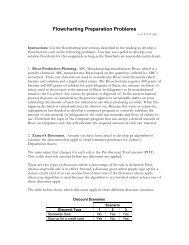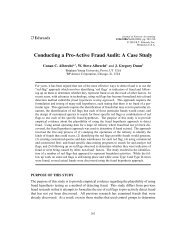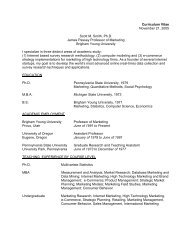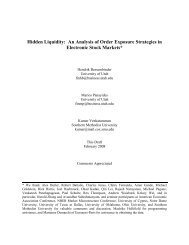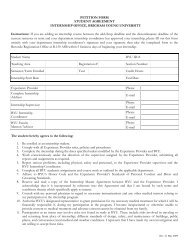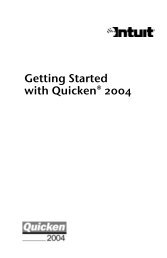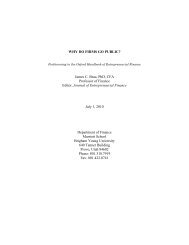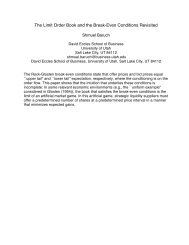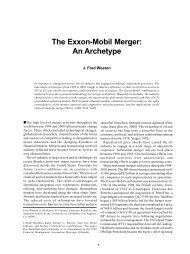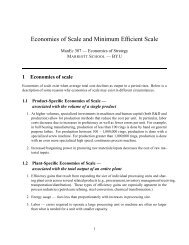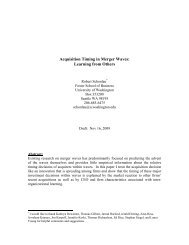Albrecht 19.pdf - Marriott School
Albrecht 19.pdf - Marriott School
Albrecht 19.pdf - Marriott School
Create successful ePaper yourself
Turn your PDF publications into a flip-book with our unique Google optimized e-Paper software.
76154_23_ch19_p942-1006.qxd 3/1/07 3:35 PM Page 1004<br />
1004 Part 6 Control in a Management Accounting System | EOC<br />
After six months of operations, Petersen was disturbed over the lack of attention paid to<br />
the standards by his potters. He felt that the potters were just too set in their ways to adhere<br />
to the new system. Many of the potters told Petersen that the new system was “confusing”<br />
and didn’t help them in their work. In reviewing the June production results, the<br />
following actual costs were noted in connection with manufacturing 1,145 toilets:<br />
Materials used:<br />
Raw clay . . . . . . . . . . . . . . . . . . . . . . . . . . . . . . . . . . . . . . . 28,900 lbs. @ $0.92 per lb.<br />
Glazing mix . . . . . . . . . . . . . . . . . . . . . . . . . . . . . . . . . . . . . 5,900 lbs. @ $0.78 per lb.<br />
Direct labor:<br />
Molding . . . . . . . . . . . . . . . . . . . . . . . . . . . . . . . . . . . . . . . . 1,200 hrs. @ $15.25 per hour (average)<br />
Glazing . . . . . . . . . . . . . . . . . . . . . . . . . . . . . . . . . . . . . . . . 600 hrs. @ $15.00 per hour (average)<br />
Actual variable manufacturing overhead . . . . . . . . . . . . . . . . . . $5,120<br />
Actual fixed manufacturing overhead . . . . . . . . . . . . . . . . . . . . $9,700<br />
1. Compute all cost variances for the month of June.<br />
2. What suggestions do you have for Mr. Petersen regarding his new standard cost system<br />
Source: Adapted from J. K. Shank, “Petersen Pottery” case, Cases in Cost Management: A Strategic<br />
Emphasis (Cincinnati: South-Western, 1996).<br />
AA 19-74<br />
INTERNATIONAL<br />
AA 19-75<br />
ETHICS<br />
Target Costing in Japan<br />
Japan is always a good place for useful insight on innovative management accounting practice<br />
and technique. From early on, the Japanese recognized that the most efficient way to<br />
keep costs down was to design them out of their products, not to reduce them after the<br />
products entered production. This realization reflects a fundamental reality of cost management<br />
in Japan; the majority of a product’s costs (as much as 90 to 95% according to some<br />
experts) are “designed in.” Consequently, effective cost control programs in a Japanese business<br />
typically focus heavily on the design process for a particular product. This is done primarily<br />
using a concept known as target costing, as well as value engineering (VE). Target<br />
costing is used to determine what the market is willing to pay for a product. Using the target<br />
market price (i.e., the price required to win the customer’s business), the manager then<br />
subtracts the target profit to arrive at the target cost. After the target cost is determined, VE<br />
then is used to design the product in order to achieve the prespecified targeted level of<br />
costs. Thus, target costing manages costs by effectively designing into the products and<br />
processes the required costs in order to achieve the desired profit.<br />
What do you think is the effect of target costing and VE on the use of variances<br />
Specifically, will materials usage variances and labor efficiency variances be more or less important<br />
to a firm that strictly uses target costing and VE versus a traditional firm that is more<br />
focused on controlling daily production processes<br />
Cool Air, Inc.<br />
Jack Lear, an internal auditor for Cool Air, Inc., met with Paul Marsh, the manager of the<br />
cost accounting department, to discuss a concern about a possible “glitch” in the standard<br />
cost system. Jack explained that he had been reviewing the employee time cards in the<br />
company division where air-conditioning units and refrigerators were assembled. The time<br />
cards reflected how much employee time was devoted to the assembly of air-conditioning<br />
units and how much time applied to refrigerators. Jack’s concern was that the hours actually<br />
charged for each of these operations always seemed to be right on target with the standard<br />
labor times for each air-conditioning unit and each refrigerator unit assembled; yet Jack had<br />
been told a number of times by employees in the assembly department that the standard<br />
hours for assembling air-conditioning units were too low. The employees felt that they could<br />
not meet these standards without “fudging” their time cards or sacrificing some quality work<br />
in the assembly process. Since company policy emphasized product quality, Jack suspected<br />
that time sheets were being modified by shifting hours worked on air-conditioning units to<br />
the time sheets for assembling refrigerators.<br />
(continued)



